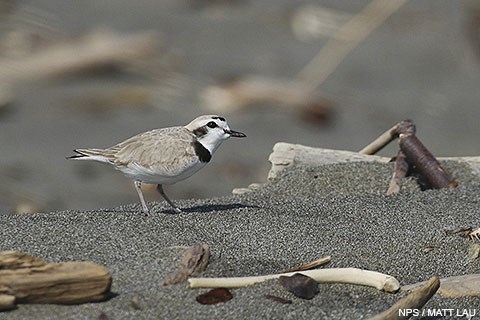
BackgroundThe U.S. Fish and Wildlife Service declared the western snowy plover (Charadrius nivosus nivosus) as federally threatened in 1993, in response to a significant decline in the last century. They identified three factors thought to be limiting population recovery: 1) habitat loss and degradation due to beach development and invasive dune plants, 2) human disturbance, and 3) predation. Current population estimates of western snowy plovers along the Pacific Coast are no more than 2,500 birds. Snowy plovers are small shorebirds (sparrow-sized, ~6 inches long) with gray legs, short black beak, and pale gray-brown upperparts, and snowy white underparts. During the breeding season, males develop dark black ear patches, black foreheads, and a black neck collar; females are much less contrasting. 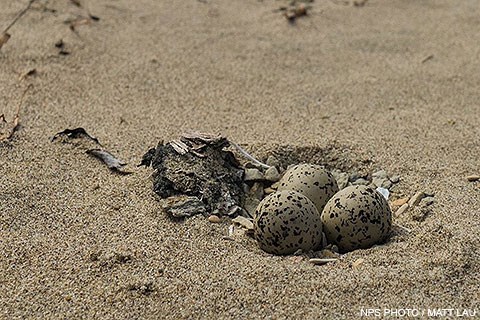
In Point Reyes National Seashore, they nest on sandy beaches in unvegetated to sparsely vegetated areas among woody debris and shells. Their eggs are laid in open depressions in the sand, vulnerable to predators and being trampled. The breeding season begins in mid-March and lasts until mid-September. Typically, two to three eggs are laid, which are then incubated by both male and female for approximately twenty-eight days. Once hatched, the chicks are fully mobile and are usually tended to by the male for another twenty-eight days until they are fledged. The female finds another free male to start a new nest, leaving the male solely responsible to raise the chicks. Partnering Science and Education to Save a Threatened SpeciesSince 1995, Point Reyes National Seashore (PRNS) has partnered with Point Blue Conservation Science (formerly known as PRBO Conservation Science and Point Reyes Bird Observatory) and Point Reyes National Seashore Association to implement a recovery project for the breeding western snowy plover (Charadrius nivosus nivosus) population within the Seashore. 
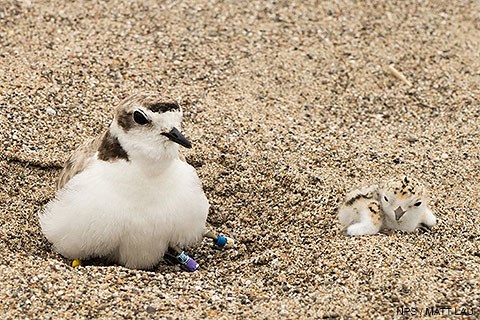
Share the Beach—Being Mindful of Human Activities that Affect PloversSeemingly benign beach activities can pose significant threats to plovers here at Point Reyes. Beaches provide open spaces for us to relax and play but some things we love to do at the beach spell disaster for the snowy plover. The peak of human activities on Point Reyes beaches usually coincides with the "snowie's" breeding season (March through September). Walking dogs or riding horses near nests flushes protective parents, leaving eggs and chicks exposed to wind, sand, cold, and predators. Food scraps left on beaches attract predators that would not have otherwise found the odorless, camouflaged plover eggs. Ravens, gulls, foxes, coyotes, feral cats, skunks, and raccoons are well known for developing feeding habits based on human disturbance and often congregate where people recreate. Even simply standing a stick in the sand as a flagpole can draw predators: the stick provides a perch for raptors that otherwise have no vantage points on barren beaches. 
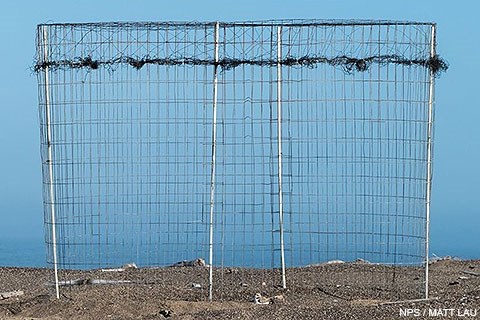
Management MethodsScientists from Point Blue Conservation Science and the National Park Service (NPS) have been monitoring snowy plovers at Point Reyes since 1986. Over the years, the NPS has used a variety of management measures that would help the plovers reproduce successfully, including: erecting exclosures around vulnerable nests, erecting symbolic fencing for seasonal closures around nesting habitat, conducting habitat restoration to provide more nesting habitat, and closing sections of the Great Beach to reduce human disturbance on nests and broods. Our circular exclosures are approximately 5 feet tall and 5 feet wide and are designed to allow an entrance and exit for nesting plovers, but prevent predators from entering to depredate the eggs. Plover biologists erect symbolic fencing along Point Reyes Beach and Limantour Beach prior to the breeding season to protect nesting habitat. 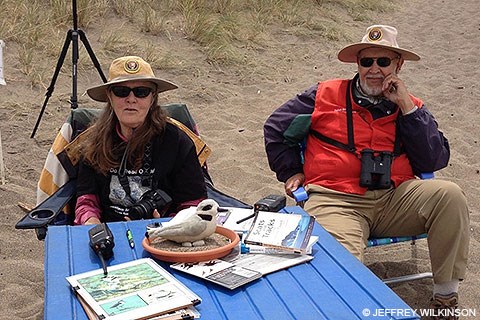
To reduce human disturbance of plovers, the park uses educational signs and brochures to teach the public about the vulnerability of nesting snowy plovers and to alert visitors to seasonal closures and pet restrictions in plover habitat. On weekends, when recreation is most intense, park employees and volunteer docents are present on beaches and at trail heads to educate visitors since 2001. These snowy plover docents provide education to between 2,300 and 4,500 visitors annually. Fewer chicks are lost on weekends and holidays since the program began, suggesting that docents' presence and education efforts are playing a critical role in sustaining snowy plover breeding populations in PRNS. Visitor education is very important to the success of plovers at PRNS because the birds are easily disturbed by recreationists on beaches. Furthermore, since 2016, the NPS began closing the section of beach between North Beach parking lot and Abbotts Lagoon on weekends and federal holidays, specifically to reduce human disturbance on nesting birds and broods. In the past, the NPS has observed decreased plover chick survival on weekends. The park will continue the protection, restoration, and education programs in the future until the population reaches and is sustained at the U.S. Fish and Wildlife Service (USFWS) recovery plan target number of sixty-four breeding birds for Point Reyes beaches. There were thirty-nine breeding birds in 2016, twenty-nine in 2014, and an all-time low of nine in 2012. 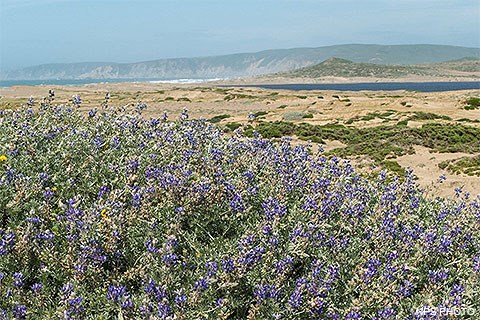
Habitat RestorationIn conjunction with this recovery program, the park initiated coastal dune restoration efforts at Abbotts Lagoon in 2001 to protect endangered plants and increase nesting habitat for snowy plovers. From 2001 to 2005, 50 acres of non-native European beachgrass (Ammophila arenaria) and iceplant (Carpobrotus edulis) have been removed from critical dune habitat. A larger restoration effort immediately south of Abbotts Lagoon in 2011 created an additional 250 acre natural dune environment for native vegetation and breeding snowy plovers. 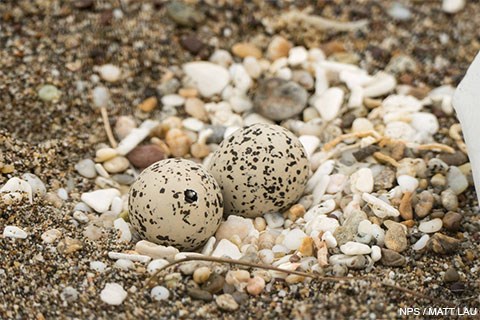
Since March 2004, plovers have begun to nest in the restored dune areas. This is the first time plovers have used these back dunes in decades. Prior to the dune restoration, plover nesting activity had been restricted to a narrow strip of sand between the beachgrass-formed sea wall and the high tide line. Snowy plovers highly prefer wide-open beaches, giving them unhindered views of their surroundings. By removing the dense clusters of European beachgrass, the habitat opens up to low-lying native dune vegetation and sand, giving plovers more habitat to nest and raise their chicks. Plovers are using the area for chick rearing as well. Male plovers have been seen moving chicks to this area from as far as a mile and a half away. The restored area is open enough for plovers to see approaching predators and provides areas of protection (chicks are much harder to find in open sand fields) and native food sources. 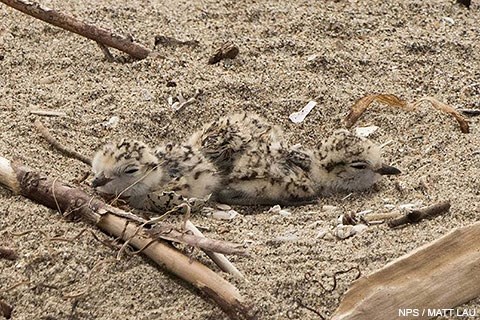
Why Should I Care?The number of snowy plovers on our beaches who reside, nest and fledge their young is an indicator of the health of our sandy beaches and coastal ecosystem. Western snowy plovers will survive as a species as long as they have protected nesting habitat. The snowy plover is an important part of the interconnected web of life on the shore. Plovers have lived on California beaches for thousands of years, but today human use of their remaining beach habitat seriously threatens their survival. Once numbered in the thousands, no more than 2,500 breeding plovers remain (USFWS unpublished data). Prior to 1970 they nested at 53 locations in California, while today they nest in only half as many sites (USFWS 2001). The health of our beaches and community will depend on our local management and community response during the critical breeding season. 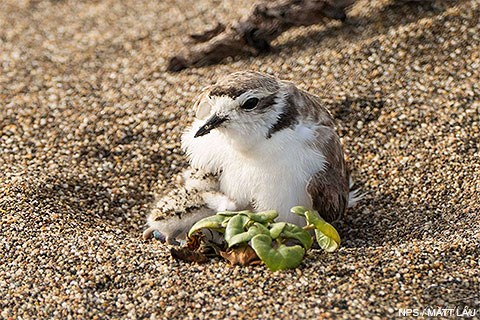
How Can I Help "Snowies" Nest in Peace?The efforts of the National Park Service, state parks, and other land management agencies, combined with your active cooperation, can make a difference in the survival of the western snowy plover along the seashore. Since snowy plover breeding season coincides with the peak of human visitation, there are many things park visitors can do to avoid or minimize impacts on the birds.
Science & Research Project SummariesFrom 2006 to 2018, Point Reyes National Seashore and Pacific Coast Science and Learning Center (PCSLC) staff and communication interns assisted scientists conducting research through the PCSLC and the San Francisco Bay Area Inventory & Monitoring Network to produce a series of Resource Project Summaries, two of which were about snowy plovers. These one- to two-page summaries provide information about the questions that the researchers hoped to answer, details about the project and methods, and the results of the research projects in a way that is easy to understand.
Learn More! Additional ResourcesNPS ResourcesView the Snowy Plover Glossary for an explanation of unfamiliar terms. Pacific Coast Science and Learning Center's Western Snowy Plovers Download the "Save Our Seashore and Protect the Western Snowy Plover" brochure. (415 KB PDF) Learn more about NPS Inventory and Monitoring Programs U.S. Fish & Wildlife Service ResourcesEnvironmental Conservation Online System: Western snowy plover (Charadrius nivosus nivosus) species profile Designated in Federal Register 70:56969; September 29, 2005. (4,599 KB PDF) Recovery Plan for the Pacific Coast Population of the Western Snowy Plover (Charadrius alexandrinus nivosus), September 24, 2007. (35 KB PDF) Learn more about Threatened and Endangered Species Additional ResourcesWestern Snowy Plover: Tools & Resources for Recovery Get Involved! Learn more at California Coastal Commission. Visit the National Audubon Society's How to Become a Bird-friendly Beachgoer page and watch their 3 Ways to Share The Shore video. Literature Cited:Campbell, C. 2013. Monitoring Western Snowy Plovers at Point Reyes National Seashore, Marin County, California: 2012 annual report. Natural Resource Technical Report. NPS/SFAN/NRTR—2013/825. National Park Service. Fort Collins, Colorado. Published Report-2204673. Available at https://irma.nps.gov/DataStore/Reference/Profile/2204673 (accessed on 17 December 2018). (1,245 KB PDF) Hornaday, K., I. Pisani, and B. Warne. 2007. Recovery Plan for the Pacific Coast Population of the Western Snowy Plover (Charadrius alexandrinus nivosus). Department of the Interior, U.S. Fish and Wildlife Service, Sacramento, California, USA. Available at http://ecos.fws.gov/docs/recovery_plan/070924_2.pdf (accessed on 17 September 2017). (2,677 KB PDF) Hughey, L. 2011. Monitoring Western Snowy Plovers at Point Reyes National Seashore, Marin County, California, 2010 Annual Report. Natural Resource Technical Report. NPS/SFAN/NRTR—2011/503. Department of the Interior, National Park Service, Fort Collins, Colorado, USA. Available at https://irma.nps.gov/DataStore/Reference/Profile/2180556 (accessed on 17 December 2018). (2,310 KB PDF) Hughey, L. 2012. Monitoring Western Snowy Plovers at Point Reyes National Seashore, Marin County, California, 2011 Annual Report. Natural Resource Technical Report. NPS/SFAN/NRTR—2012/645. Department of the Interior, National Park Service, Fort Collins, Colorado, USA. Available at https://irma.nps.gov/DataStore/Reference/Profile/2191490 (accessed on 17 December 2018). (1463 KB PDF) Lau, Matthew J.; Becker, Benjamin H.; and Press, David T. (2022) "Common Raven Impacts on the Productivity of a Small Breeding Population of Snowy Plovers," Human–Wildlife Interactions: Vol. 15: Iss. 3, Article 13. Available at https://digitalcommons.usu.edu/hwi/vol15/iss3/13 (accessed 26 June 2022) Page, G. W., and L. E. Stenzel. 1981. The breeding status of the Snowy Plover in California. Western Birds 12: 1–40. Available at http://sora.unm.edu/sites/default/files/journals/wb/v12n01/p0001-p0040.pdf (accessed on 17 September 2017). (553 KB PDF) Peterlein, C.R. 2009. Monitoring Western Snowy Plovers at Point Reyes National Seashore, Marin County, California, 2008 Annual Report. Natural Resource Technical Report. NPS/SFAN/NRTR—2009/180. Department of the Interior, National Park Service, Fort Collins, Colorado, USA. Available at https://irma.nps.gov/DataStore/Reference/Profile/661277 (accessed on 17 December 2018). (545 KB PDF) Schwarzbach, S. E., M. Stephenson, T. Ruhlen, S. Abbott, G.W. Page, and D. Adams. 2005. Elevated mercury concentrations in failed eggs of Snowy Plovers at Point Reyes National Seashore. Marine Pollution Bulletin 50: 1433–1456. Available at http://www.sciencedirect.com/science/article/pii/S0025326X05003851 (accessed on 17 September 2017). U.S. Fish and Wildlife Service. 1993. Endangered and threatened wildlife and plants; determination of threatened status for the Pacific coast population of the western snowy plover, final rule. Fish and Wildlife Service. Federal Register 58(42):12854-12874. Available at http://ecos.fws.gov/docs/federal_register/fr2236.pdf (accessed on 17 September 2017). (4,278 KB PDF)
|
Last updated: December 26, 2024
